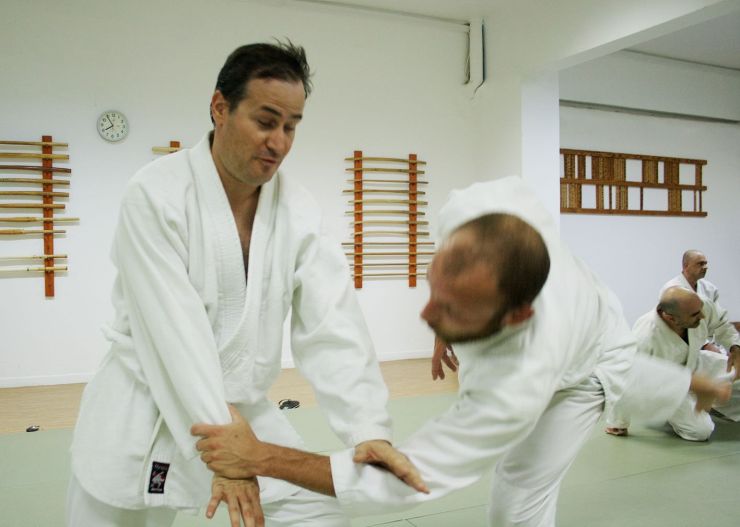• Aikido practice is carried out on mats identical to those used for judo practice. This provides a safe environment for learning Aikido techniques as well as learning basic safe falling techniques.
Many of the unique characteristics of Aikido make it very suitable for the blind and people with limited vision. These characteristics include:
• Aikido practice is a cooperative, not competitive, enterprise. Techniques are learned through practicing with a partner, not an opponent. The goal is for each partner to help the other improve themselves. Each person is always dealing and working with their own personal limitations, whatever they may be.
• Aikido techniques are based on the principles of Jiu-jitsu which is also the origin of modern judo techniques. Many of these techniques involve attacks such as gripping the hands, shoulders, lapels etc. These types of attack and the techniques to neutralize them are directly practical for blind people.

• Through practicing the dynamic circular movements of aikido techniques, aikido practitioners develop the ability to move confidently in all spatial directions and to use whatever space is available to them in an efficient manner.
• One of the basic principles in applying aikido techniques is how to take one’s partner balance. In learning how to do this, we learn a lot about how to maintain our own balance in both static and dynamic situations.
It is important to understand fully the importance and functioning of the principle of non-competition in Aikido. This approach has as its base the fundamental difficulty in practicing effective martial techniques in a safe manner.
Genuinely effective techniques applied to an unprotected practicing partner would result in injury. One method of dealing with this problem is to limit the attacks and techniques to those that cannot result in injury. Another approach is to allow strong attacks and powerful techniques but to protect the person receiving the technique by mutual agreement on the form and intensity of the techniques being applied. The latter approach, that of mutual understanding and collaboration rather than competition, is the one used in traditional martial arts and is retained in Aikido practice.

This principle of non-competition in Aikido also contains the basic understanding that our practice of Aikido is not focused in any way on striving to be better than others, but on improving ourselves. Our own condition and happiness is not in any way contingent on being superior to someone else or in striving to attain any goal set by others. Comparisons between individuals are essentially meaningless and to pursue and emphasise them is a fruitless use of our time and energy. Each person has different abilities and physical characteristics. Some learn quickly and others slowly. This is not of much importance in the long term. The important thing is to be constantly improving ourselves, however gradual the process. In this way genuine personal satisfaction is found. As the founder of Aikido realized the fruitlessness of a path based on victory over others, Aikido practitioners do their best to embody this understanding.
In harmony with this understanding it is the policy of the Aikido of Athens dojo to create an environment where blind/visually impaired people can practice together in a natural and equal way. After extensive basic practice in techniques and falling methods, blind and visually impaired members will be able to practice with other non-blind members.

